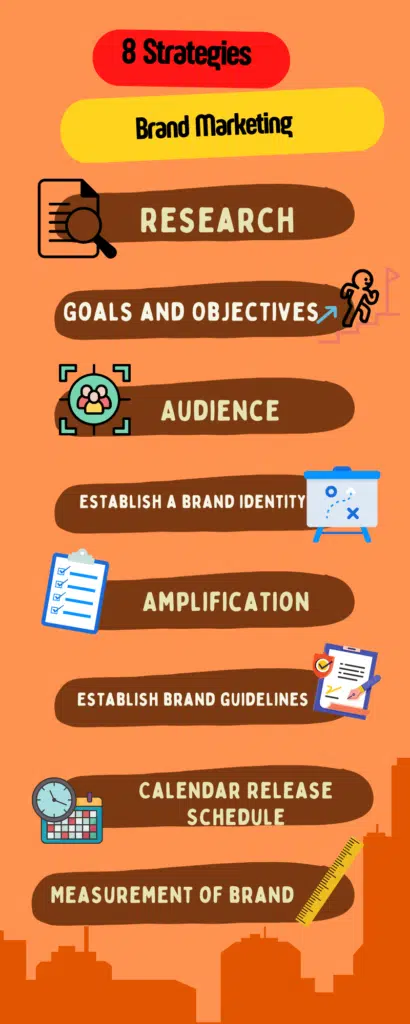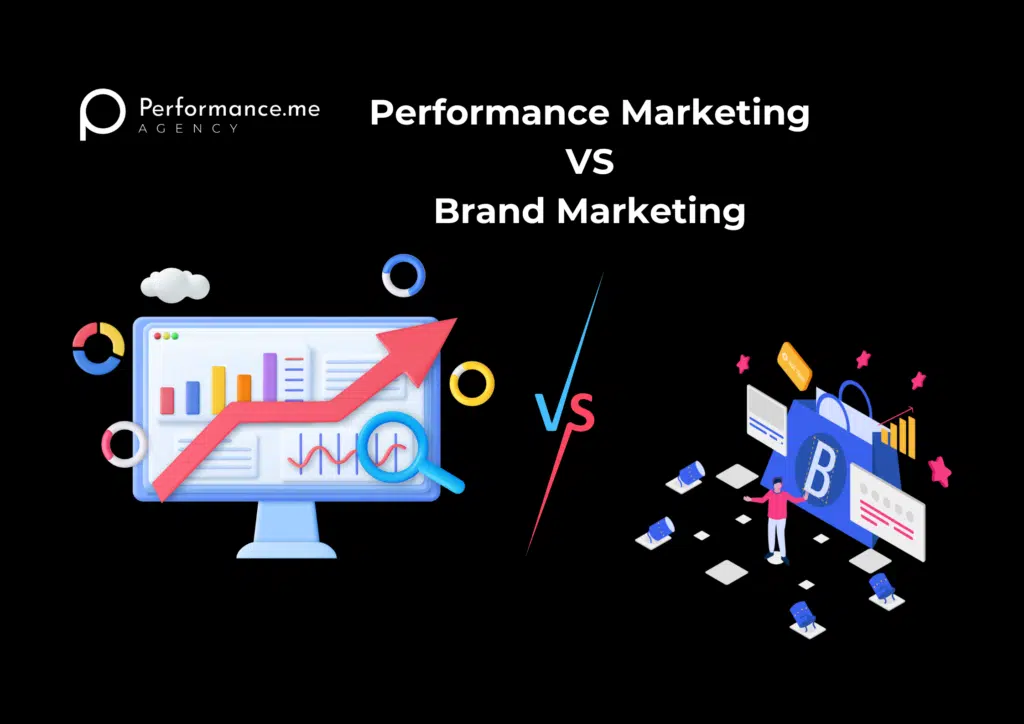The words branding and marketing are common, but it is best to understand the difference between branding and marketing.
Brand marketing helps to promote a brand’s products or services. It also helps develop and maintain brand-consumer relationships and marketing brand attributes.
This article covers a brief explanation of brand marketing, strategies used in brand marketing, and the goals and trends used in brand marketing.
Table of Contents
- What is Brand Marketing?
- What are the strategies used for Brand Marketing?
- Steps to develop brand marketing
- What are the benefits of using Brand Marketing?
- Frequently Asked Questions
- Quick Recap
What is Brand Marketing?
Brand marketing is the process of creating a relationship between a brand and a consumer. It highlights or promotes the entire brand with the help of products and services.

The ultimate goal of brand marketing is to build a brand’s value, and it increases the company’s results. To promote your brands, the available channels include digital, social, and paid search advertising.
You can also use some additional channels like email marketing and content marketing which helps to reach potential customers. However, it is important to know the right messages for the right audiences. For that, you need to know about the brand attributes.
Related Reads
- Brand Performance Marketing: How Does Branding Work with Performance Marketing?
- What is Influence Marketing, and How Does it Help Performance Marketing?
What are Brand Attributes?
Everyone has their own personality and traits. Likewise, every brand has its unique attributes as well. The consumer will always take a look at the attributes of every brand. The attributes include the brand’s color name, tagline, and music or sound the brand associates with.
Strategies used for Brand Marketing
A brand strategy plays a prominent role in developing a brand. Every brand strategy should have the following elements.
- Research
Research outlines the competitive landscape and how the brand addresses a particular demand. It is crucial in the foundation for a company’s brand-building strategy. This aids the brand in developing attainable growth objectives and gaining insight into its competitors’ positioning.
- Goals and Objectives
Goals and objectives include the broad brand goal and quantifiable brand and marketing indicators. What does the brand promise? What can customers anticipate from each engagement with a brand? A company can better define who they are and what function they fulfill for customers by working backward and responding to these questions first.
- Audience
Every brand and marketing plan should include precisely defined audiences based on internal and external data. You can also create imaginary customer personalities called personas. It also includes demographic and behavioral data to assist in guiding the brand’s media buying, strategy, and tone of voice to target the appropriate demographics.
- Establish a brand identity
When it comes to branding, identity refers to all of the visual components that come together to form the brand’s visual expression. Name, logo, tagline, color scheme, typefaces, and image style are all examples. Having a distinct and unified brand identity helps to raise awareness.

- Amplification
Internal messaging concentrates on interacting with stakeholders and workers, and external messaging concentrates on interacting with consumers. Definitions of the brand’s goal, vision, values, and positioning statement. These includes what the brand does, for whom, and how it fulfills its brand promise. If brand storytelling is done well, buyers will remember these components of the brand longer than they will remember the specific things they purchased.
- Establish brand guidelines
Brand guidelines explain how and when to employ various brand aspects to maintain consistency across the board. Brand standards define the brand’s voice and tone, emphasize image style, provide a content style guide, and show how to use a logo and typeface properly. The ability for businesses to roll out a brand at scale as everyone builds from the same toolbox makes brand guidelines a crucial component of brand and brand marketing strategy. Additionally, this refers to the brand asset library, from which marketers can select authorized brand materials.
- Calendar Release Schedule
You must also include a rollout schedule for brand marketing initiatives, along with information on the launch dates for components like a supportive digital advertising campaign and a complementing online presence. Remember that everything must be altered if there is a rebrand, including email signatures, social media assets, newsletter layouts, and signage.
- Measurement of brand
It’s crucial to provide specific metrics and information about how a business intends to track and evaluate both short- and long-term brand success. The net promoter Score, which analyzes customer feeling, the customer satisfaction Score, brand recognition and awareness, brand relevance, and distinction are some examples of measurement tools for brand satisfaction.
Suggested Reads
Steps to Develop a Brand Marketing Strategy
Although brand marketing plans exist in various forms and sizes, they often begin by answering three crucial questions about your product and what makes it unique.

By choosing, you can determine your brand positioning.
Whom are you aiming for?
You should be able to identify a particular customer demographic and type for your goods or services. Knowing your audience helps you perform as a corporation. It’s similar to how you would respond differently to a friend than a parent.
What is the need that you are addressing?
Consider what people can do with your goods or services. It’s all about framing your products as a facilitator for a particular lifestyle rather than just a quick remedy to a problem in brand marketing.
Why ought they to believe you?
This is what distinguishes you. Identifying your unique selling proposition will give you a justification for why people should trust your brand as much as you do. It can be an exceptional deal, a long history of dependability, or amazing customer service.
It is important to let your viewers know about the brand’s marketing strategy. It also helps them maintain the consistency of their brand.
Also Reads
Benefits of Brand Marketing

- Client Appreciation
When consumers identify a brand’s color, theme, logo, etc., from an advertisement, they are more likely to select that product over all others. They are already aware of your brand and what it represents. A solid brand can appear as anything from plain and understated to outlandish and striking among a sea of competitors.
- Client Loyalty
Good branding will keep customers coming back for more after recognizing and purchasing a product or service. A good business with excellent products and strong branding resonates strongly with customers. This will boost client loyalty in the long term. Apple is a fantastic example of a company that values its customers.
- Reliability
A strong brand lays the groundwork for a company. All other initiatives can be based on a company’s branding, which includes its corporate philosophy, colours, font, and other elements.
This foundation is the base for all subsequent marketing initiatives. Customers can relate to a brand better because of the consistency this develops. Imagine a business where the logo changes every two months. Most consumers would feel perplexed and would even decide against purchasing goods and services from inconsistent brands.
- Reputation
Every customer has trust difficulties when it comes to experimenting with new goods or services, but a strong brand can help you stand out as a reputable company with core principles where clients may identify. Fresh advertising, combined with products and services, should have phenomenal customer service, and interesting visuals will surely help to establish your business.
Frequently Asked Questions
1. How effective is brand marketing?
Loyal customers are produced by branding. It's essential to have a clientele of repeat clients rather than just those who know your brand and have used your services once. Your clients are more likely to relate to your brand if you use strong branding than to a business solely focused on its bottom line.
2. What is Branding Strategy?
The comprehensive technique used to develop a brand's recognition and potential customers is known as a brand strategy. A brand strategy includes various distinctive components, such as voice, storytelling, brand identity, brand values, and general vibe.
3., What are the three primary objectives of branding?
The three major objectives of branding for a company are to shape consumers' associations with and feelings toward the brand, to establish a distinctive identity, and to encourage long-term loyalty.
Wrapping Up
Brand marketing emphasizes the strengths of a brand to give power to a long term for your brand. It also focuses on strengthening the relationship between brands and consumers.
It helps businesses to promote their brand with unique stories. It sparks interest and invites customers to discover and learn about you. Brand effectively creates a lasting impression that helps grow loyalty among customers for the long term.



